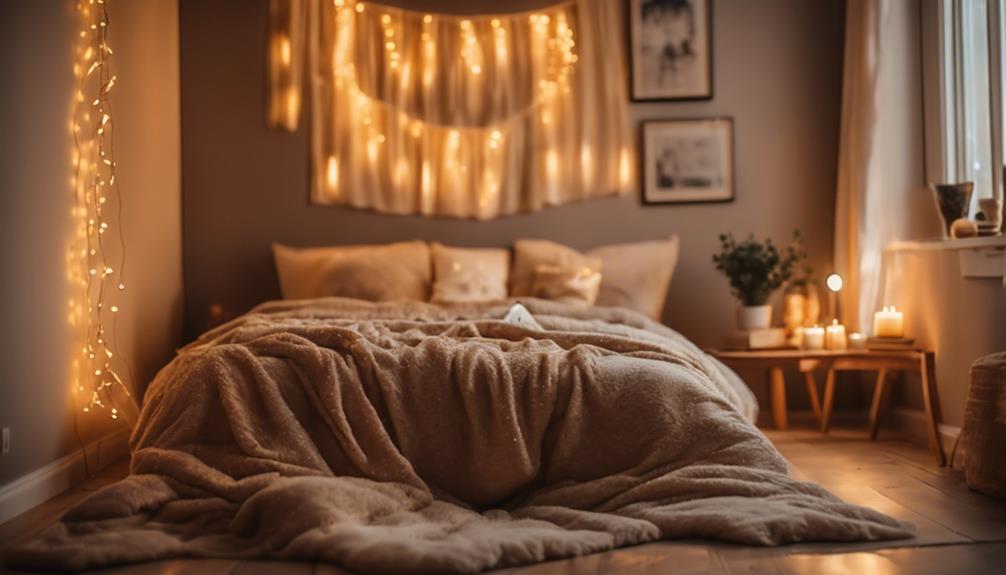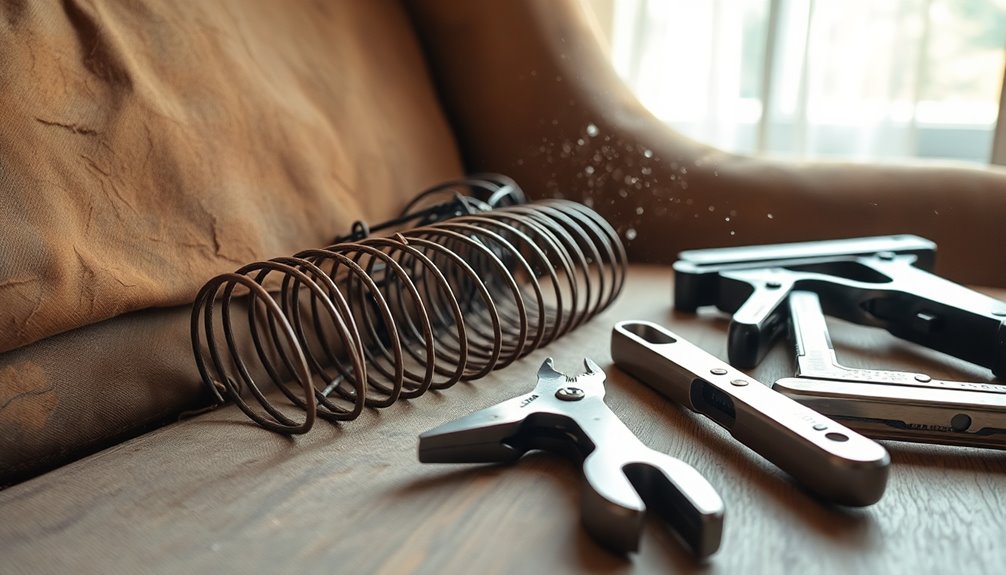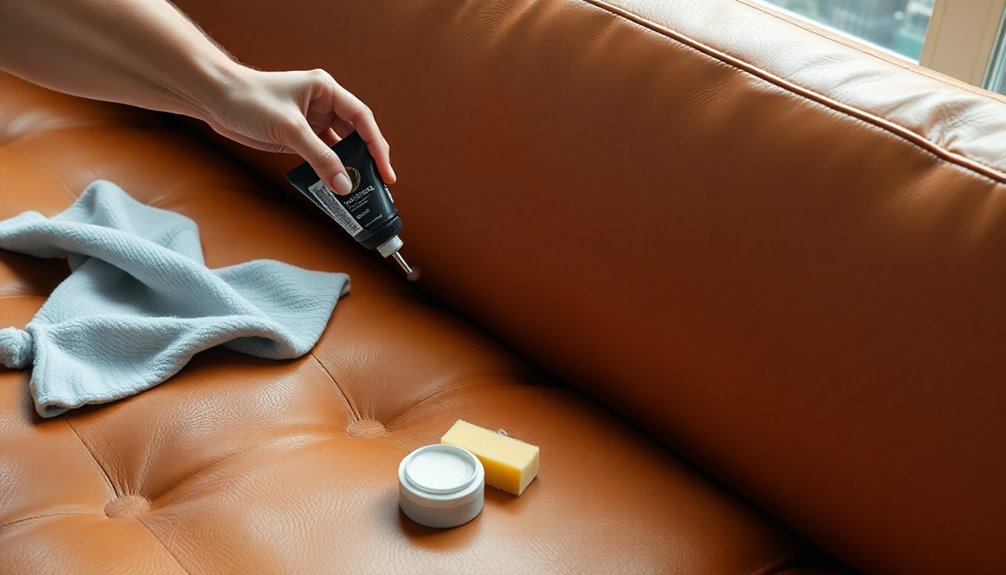Transform your space into a captivating witch room full of mystical charm and enchanting details effortlessly. Kick things off with a color palette of deep greens, purples, and rustic browns to establish a welcoming ambiance. Enhance the atmosphere by incorporating key elements such as antique candle holders and unique furniture to add character. Soft lighting provided by candlelit chandeliers or fairy string lights will bring warmth and whimsy to the space. Elevate your decor with vintage spellbooks, crystal centerpieces, and tarot hangings. Consider finishing touches like a dark-stained hardwood floor or a woven rug to anchor the room. If you’re intrigued, there’s plenty more to discover to achieve that perfect witchy vibe!
Key Elements
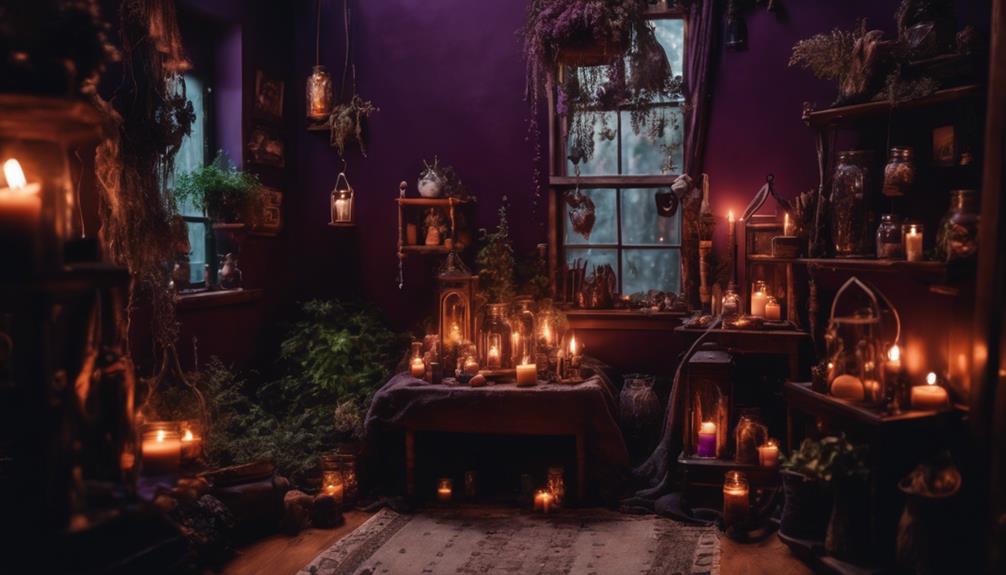
When creating your witch room, pay close attention to the color scheme, materials, and textures.
These elements set the tone and feel of the space, making it uniquely yours.
Color Scheme
A witch room's color scheme combines deep greens, rustic browns, and dark hues like black and deep purple to create a mystical and grounding atmosphere. This palette not only evokes the essence of nature but also encourages a sense of connection to the spiritual world. You can enhance your space by incorporating accent colors like silver and mystical purples, which add enchanting pops of color.
Contrasting shades in your color scheme provide depth and visual interest, making your room feel dynamic and inviting. Soft lighting plays an essential role in showcasing your chosen hues, fostering a tranquil environment perfect for spiritual practices.
Consider mixing earthy tones with Halloween-inspired colors like orange and black, which can help you achieve a distinctive witchcore aesthetic. Don't forget the elegance that gold accents can bring; they enrich the overall design while maintaining that witchy vibe.
Materials
Essential materials like candles, mirrors, and deities' statues form the foundation of a witch room, creating an atmosphere rich in energy and intention.
Candles set the mood and serve as tools for spellwork, while mirrors amplify energies, reflecting your desires and intentions back to you. Statues of deities invoke specific energies, guiding your practices and rituals within your witchy sanctuary.
Incorporate natural elements like plants, dried herbs, and crystals to deepen your connection to nature and the supernatural.
These materials not only enhance the aesthetic but also bring a vibrant, living energy to your space. Apothecary bottles filled with mysterious ingredients and potion-making equipment like cauldrons and flasks add both whimsy and practicality to your decor, encouraging exploration and creativity.
Consider updating your materials seasonally with items that reflect nature's cycles, such as autumnal decorations or fresh spring florals.
This keeps your witchy sanctuary dynamic and aligned with the rhythms of the earth. By thoughtfully selecting these key materials, you'll cultivate a space that feels both magical and personalized, inviting inspiration and intention into your daily practices.
Textures
Incorporating luxurious textures like velvet and lace instantly transforms your witch room into a cozy, mystical retreat. These materials work beautifully for upholstery and curtains, enveloping the space in an enchanting atmosphere. Layering rugs with varying textures adds depth and warmth, creating an inviting environment that draws people in.
Consider using tapestries adorned with occult symbols or ethereal patterns as wall decor. These pieces introduce rich textures that catch the eye and spark conversation. To enhance comfort and visual interest, select throw pillows featuring witch-themed prints or intricate embroidery for your seating areas. They serve as the perfect accents that invite relaxation.
Don't forget to integrate natural elements like wood and stone in your furniture and decor. These earthy textures connect your witch room to nature and magic, grounding the mystical vibe you're cultivating. The combination of soft, luxurious fabrics and natural materials creates a balanced atmosphere that captivates everyone who enters.
Essential Fixtures and Furniture
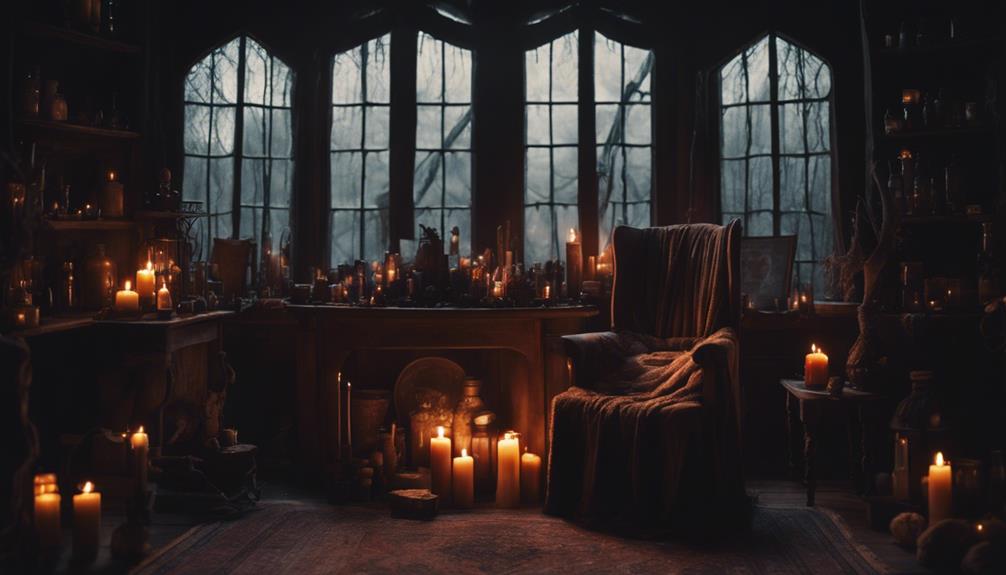
When it comes to essential fixtures and furniture for your witch room, think about unique pieces that add character and functionality.
An antique wooden cauldron table or a crystal ball side table can set the perfect tone, while gothic iron candle holders create an enchanting ambiance.
These elements not only serve practical purposes but also enhance the mystical atmosphere you're aiming for.
Antique Wooden Cauldron Table
An antique wooden cauldron table adds a touch of whimsy and functionality, making it a standout piece in your witchcore room. This unique table serves as a focal point, combining the charm of potion-making lore with practical uses. With intricate carvings and a rustic finish, it enhances your space's mystical vibe while providing ample surface area for spellwork, crafting, or displaying decorative items.
Many antique cauldron tables mimic traditional cauldrons, featuring rounded legs or a bowl-like top that creates an enchanting atmosphere. By incorporating this table, you not only elevate your room's aesthetic but also encourage creativity and inspiration. It becomes a dedicated space for rituals, tarot readings, or simply enjoying a cup of herbal tea with friends.
Sourcing an antique wooden cauldron table from thrift stores or estate sales adds character to your witch room, all while supporting sustainable practices by repurposing vintage furniture. As you design your space, consider how this striking piece can transform your ambiance, inviting both magic and functionality into your daily life. You'll find that it's more than just furniture; it's a catalyst for inspiration and connection.
Crystal Ball Side Table
A crystal ball side table adds a magical touch to your witch room while serving as a functional and eye-catching decor piece. This enchanting furniture not only embodies the mystical essence of witchcore aesthetics but also provides a practical surface for your needs. Crafted from materials like glass or resin, these tables often feature intricate designs and may incorporate actual crystal spheres to enhance their appeal.
You can use your crystal ball side table to display other witchy items, such as tarot cards, candles, or potion bottles. This creates a cohesive look that invites curiosity and intrigue from anyone who enters your space. Its height and size can vary, making it versatile enough to serve as a bedside table, an accent piece in your living room, or even a focal point in a magical corner.
Incorporating a crystal ball side table into your witch room not only elevates the aesthetic but also encourages a deeper connection to the mystical arts and practices. With this stunning piece, your space will radiate charm and allure, enchanting everyone who steps inside.
Gothic Iron Candle Holder
Gothic iron candle holders not only illuminate your witch room but also serve as striking focal points, enhancing its enchanting atmosphere with their intricate designs and dark finishes. These essential fixtures come alive with ornate detailing, featuring filigree patterns, twisted metal, and gothic motifs like bats and skulls. They reflect the enchanting vibe of witchcraft, making them perfect for your mystical space.
You'll find gothic iron candle holders in various sizes and shapes, from elegant candelabras to wall-mounted versions. This versatility allows you to create mesmerizing arrangements throughout your room. The black or antique finishes of these holders add a touch of elegance, seamlessly complementing other witchy decor like potion bottles and crystal displays.
To elevate the ambiance further, consider incorporating scented candles into your gothic iron candle holders. Not only will they provide a warm glow, but the inviting aromas can promote relaxation and deepen your spiritual connection. With these striking pieces, you'll transform your space into a haven of mystique and charm, making every moment spent in your witch room feel truly magical.
Lighting Ideas

When it comes to lighting your witch room, you'll want to create an enchanting atmosphere that draws you in.
Think about candlelit chandeliers and witchy lanterns with flickering flames to set the mood.
Adding moonlit fairy string lights can also bring a whimsical touch while enhancing the overall vibe.
Candlelit Chandeliers for Ambiance
Candlelit chandeliers transform your witchcore space into an enchanting focal point, blending elegance with a warm, mystical glow. These stunning fixtures not only illuminate your room but also enhance its overall ambiance, mesmerizing anyone who walks in.
When choosing your candlelit chandeliers, consider intricate designs crafted from wrought iron or antique brass. These materials add a touch of history and charm that perfectly complements the witchcore aesthetic.
Incorporating dimmable candles into your chandelier allows you to adjust the lighting, setting the perfect mood for rituals or cozy relaxation. Opt for chandeliers adorned with crystals or glass elements; they'll refract candlelight beautifully, adding a magical sparkle that elevates the enchanting feel of your space.
Additionally, select chandeliers that accommodate various candle sizes. This versatility allows you to change your decor with the seasons or theme your space for special events, all while maintaining that mystical allure.
With the right candlelit chandeliers, you can create a mesmerizing atmosphere that draws everyone in, inviting them to share in the magic of your witchcore sanctuary.
Moonlit Fairy String Lights
Moonlit fairy string lights instantly elevate your witchcore space, creating a whimsical atmosphere that bathes your room in a soft, enchanting glow. These lights are perfect for enhancing the mystical aesthetic, adding a warm illumination that feels both magical and inviting. Available in various lengths and styles, you'll find designs featuring delicate crescent moons and stars that lend a celestial touch to your decor.
You can easily drape moonlit fairy string lights over furniture, hang them from walls or ceilings, or weave them through your plants to achieve an ethereal ambiance. Their versatility allows you to highlight key areas or magical corners of your space, transforming it into a serene retreat. Battery-operated options free you from worrying about nearby outlets, giving you the freedom to place them wherever your imagination takes you.
Not only are moonlit fairy string lights functional for lighting, but they also serve as decorative elements that evoke feelings of serenity and connection to the cosmos. Incorporating these lights into your witch room can bring your enchanting vision to life, making it a fascinating space for you and your guests.
Witchy Lanterns With Flickering Flames
Adding witchy lanterns with flickering flames to your space enhances the mesmerizing atmosphere created by moonlit fairy string lights. This combination fills your room with soft, ambient lighting that's perfect for rituals or relaxation.
These lanterns not only illuminate your witch room but also add a touch of vintage charm, especially when made from antique-style materials like wrought iron or glass.
Opt for battery-operated or LED lanterns to safely simulate flickering flames, allowing you to create a cozy ambiance without fire hazards. Positioning these lanterns on shelves, tables, or window sills highlights decorative elements such as crystals and herbs, casting intriguing shadows that deepen the room's mysterious allure.
Combine your witchy lanterns with other light sources like candles and fairy lights for layered lighting that can be adjusted to suit various moods or occasions. This thoughtful lighting design reinforces the mesmerizing atmosphere you're aiming for in your witch room.
With careful placement and the right materials, you can transform your space into a mesmerizing haven that invites magic and relaxation, making it a perfect retreat for rituals or simply unwinding after a long day.
Crystal-Embellished Wall Sconces
Crystal-embellished wall sconces cast an enchanting glow while doubling as striking focal points that elevate the mystical vibe of your witch room. These stunning crystal sconces not only illuminate your space but also enhance its energy with their enthralling designs. You can choose from various crystals like amethyst, quartz, or citrine, each believed to amplify energies and promote spiritual healing.
To create a warm and inviting atmosphere, opt for soft, warm-toned light bulbs. This lighting complements the witchcore aesthetic, making it perfect for both rituals and cozy relaxation. Many crystal sconces feature intricate designs, often made with wrought iron or antique finishes that align beautifully with rustic and gothic themes.
Consider installing sconces at varying heights to add depth and dimension to your room. Placing them strategically near your altar or meditation corner will enhance their mystical presence, making your witch room even more enchanting.
With crystal sconces, you're not just adding light; you're creating a magical ambiance that enthralls everyone who enters your space. Embrace the charm of these stunning fixtures and transform your witch room into a sanctuary of mystical allure.
Decorative Elements
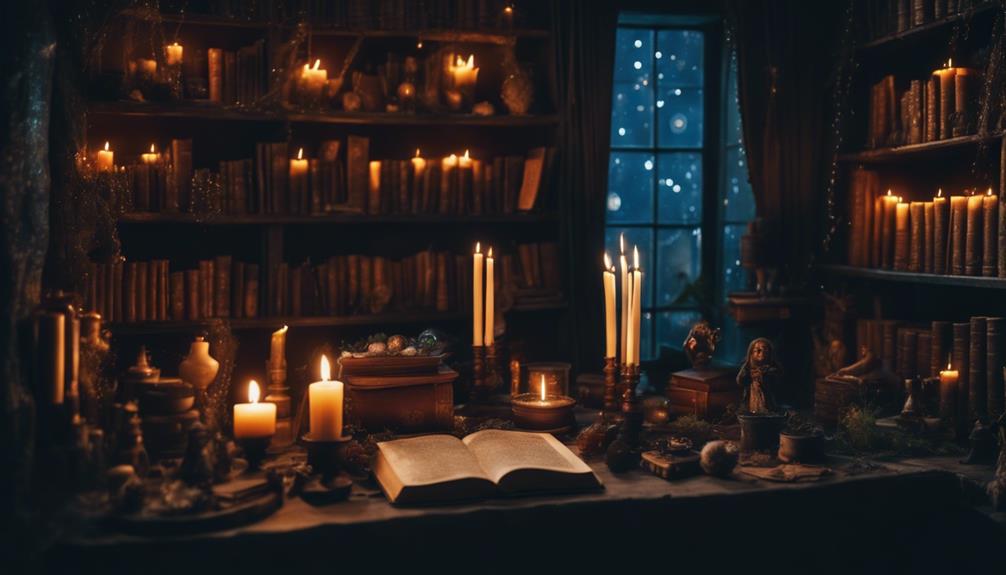
To bring your witch room to life, consider incorporating key decorative elements that resonate with your theme.
A vintage spellbook display stand, tarot card wall hanging, and an enchanted crystal orb centerpiece can add character and intrigue to your space.
These accents not only enhance the aesthetic but also create a personal touch that reflects your magical style.
Vintage Spellbook Display Stand
A vintage spellbook display stand not only showcases your treasured tomes but also enhances the mystical atmosphere of your witchcore sanctuary. This functional and decorative element allows you to keep your spellbooks easily accessible while accentuating their aesthetic appeal. You can choose stands crafted from rustic wood or wrought iron, which beautifully complement the antique vibe of your decor.
Look for intricate designs or carvings, like moons or stars, to add enchanting details that elevate the overall ambiance. Positioning your vintage spellbook display stand on a Wiccan altar or study table not only highlights your spellbooks but also encourages you to engage with your magical practices regularly. The act of displaying your books can inspire creativity and deepen your connection to your craft.
Beyond practicality, a vintage spellbook display stand serves as an intriguing conversation starter. Guests will be drawn to its unique charm and the stories behind the spells within your collection.
With this stand, you're not just organizing your books; you're creating a focal point that embodies the spirit of your witchcore sanctuary. Embrace the magic it brings to your space!
Tarot Card Wall Hanging
Elevate your witchcore decor by incorporating a tarot card wall hanging that showcases the unique artwork and symbolism of your favorite cards.
These tarot cards not only serve as decorative elements but also as sources of inspiration, bringing a mystical ambiance to your space. Their vibrant colors and intricate designs enhance your overall aesthetic, making each piece a focal point that draws attention and sparks conversation.
You can display your tarot cards in visually appealing arrangements, whether framed individually or woven into a tapestry. Using wooden or metal hangers adds an antique touch, aligning perfectly with the rustic and vintage vibes of witchcore decor.
To keep your display fresh and engaging, consider rotating your tarot cards seasonally or in accordance with your personal energy. This dynamic connection with the cards allows you to reflect on their meanings and stay inspired.
Whether you're a tarot enthusiast or simply appreciate the artistry, a tarot card wall hanging will certainly captivate everyone who enters your space, making it a cherished addition to your witch room.
Enchanted Crystal Orb Centerpiece
An enchanted crystal orb centerpiece captures the essence of witchcore decor, drawing the eye and inviting a sense of mystical energy into your space. These stunning orbs, crafted from materials like quartz, amethyst, or obsidian, symbolize spiritual connection and enhance your intuition. Placing the orb on an ornate stand or surrounded by a circle of flickering candles creates a mesmerizing display that naturally attracts curiosity.
To further amplify its enchanting presence, you can surround the enchanted crystal orb centerpiece with dried flowers, crystals, or herbs that resonate with the energies you want to attract. Each element you choose can deepen the magical ambiance and personalize the space.
Incorporating lighting elements, such as fairy lights or candles, around the orb transforms your room into a warm, inviting haven. The soft glow complements the orb's natural beauty, enhancing its mystical charm.
Whether you're using it for meditation, rituals, or simply as a striking decorative piece, the enchanted crystal orb centerpiece serves as a powerful focal point in your witch room, mesmerizing everyone's attention and igniting a sense of wonder.
Flooring

When choosing flooring for your witch room, think about dark stained hardwood floors for a rich, earthy base.
You might also love a woven black and silver rug that adds a touch of elegance while keeping it cozy.
For a more modern twist, consider moonlit grey marble tiles to create a striking, mystical atmosphere.
Dark Stained Hardwood Floors
Dark stained hardwood floors instantly transform your space, adding an elegant and mysterious touch that enhances the witchcore aesthetic. These rich, deep tones harmonize beautifully with dark furniture and decor, creating an inviting atmosphere that feels both cozy and enchanting. The natural grain patterns in dark hardwood evoke a sense of nature and history, aligning perfectly with the rustic elements often found in witchcore design.
With dark stained hardwood floors, you get durability and ease of maintenance, ensuring your sacred space remains both practical and beautiful. They visually ground a room, making it feel more intimate—ideal for candlelit rituals or cozy gatherings with friends. The warmth of these floors can envelop your space, encouraging a sense of comfort and creativity.
When you pair dark stained hardwood floors with soft textiles and enchanting decor, you highlight the mystical charm of the room. This combination draws attention and inspires creativity, allowing your witchy vibes to shine through. Embrace the enthralling environment that dark stained hardwood floors create, and watch your space transform into a magical haven.
Woven Black and Silver Rug
A woven black and silver rug adds a striking focal point to your witchcore room, enhancing the mystical atmosphere with its rich texture and intricate patterns. This rug not only serves as an eye-catching element in your home decor but also aligns beautifully with the enchanting themes of nature and magic that define a mystical home. The contrasting colors of black and silver effortlessly complement candles, crystals, and other decor, creating a magical ambiance that draws people in.
The intricate designs of a woven rug evoke a sense of enchantment, inviting you to immerse yourself in ritual, meditation, or simple relaxation. Its texture adds warmth and coziness, making your space feel inviting and tranquil.
Plus, you won't have to worry about wear and tear; these rugs are durable and easy to maintain, perfect for accommodating foot traffic during witchy gatherings.
Moonlit Grey Marble Tiles
Moonlit grey marble tiles transform your witchcore room into a serene sanctuary with their enchanting blend of soft hues and delicate veining. These tiles mimic the ethereal qualities of moonlight, making them a stunning flooring choice that enhances your mystical aesthetic. The natural coolness of marble fosters a calming atmosphere, perfect for meditation, rituals, or quiet reflection.
Not only are moonlit grey marble tiles visually striking, but they're also durable and easy to maintain, making them ideal for high-traffic areas in your witch room. Their reflective surface enhances lighting, creating an illusion of a more spacious and airy environment that complements your overall decor.
When you incorporate moonlit grey marble tiles, you're not just adding flooring; you're creating a beautiful backdrop for decorative elements like candles, plants, and potion bottles. This depth and sophistication elevate your space, allowing your witchcore vision to shine.
Whether you're performing rituals or simply enjoying a moment of peace, these tiles set the perfect foundation for all your mystical endeavors. Embrace the charm of moonlit grey marble tiles and watch your witch room come alive with magic.
How Can I Incorporate Mystical and Enchanted Elements Into My Room Design?
Transform your living space with enchanted goblincore room ideas. Add whimsical elements like fairy lights, vintage knick-knacks, and nature-inspired decor to create a mystical ambiance. Incorporate earthy tones, natural textures, and mystical symbols to bring the enchanting essence of goblincore into your room design.
Conclusion
By incorporating these witch room ideas, you can easily transform your space into a mystical haven that captivates everyone who enters.
Focus on key elements, essential fixtures, and lighting to set the mood, while adding decorative touches that reflect your personal style.
Don't forget about the flooring, as it can tie the entire room together.
Embrace the enchantment and let your creativity flow—you'll create an inviting atmosphere that feels both magical and uniquely yours!



